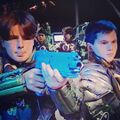Difference between revisions of "CyberMaster"
From Sega Retro
m (yep... beer...what else could be?) |
m |
||
| Line 27: | Line 27: | ||
==Gallery== | ==Gallery== | ||
<gallery> | <gallery> | ||
| + | CyberMaster.jpg|A young show contestant holds a [[Virtua Gun]] while playing Virtua Cop during a challenge of the first season of Portuguese television show ''"CyberMaster"'' | ||
CyberMaster PT Video (1996).mp4|CyberMaster PT Video (1996) | CyberMaster PT Video (1996).mp4|CyberMaster PT Video (1996) | ||
</gallery> | </gallery> | ||
Revision as of 16:08, 16 May 2019
| 320x240px |
| CyberMaster |
|---|
| Studio: Ecofilmes, Astrolábio - Produção de Televisão, S.A., Rádio e Televisão de Portugal |
| Number of seasons: 2 |
| Original airdate: 1996-12-02 — 1997-xx-xx |
| Original channel(s): RTP1 |
| Running time: approx. 23 minutes |
| Language: Portuguese |
This short article is in need of work. You can help Sega Retro by adding to it.
CyberMaster was a Portuguese, challenge-based television show focused exclusively on Sega Saturn and Sega Mega Drive video games, jointly produced by Ecofilmes, Astrolábio - Produção de Televisão, S.A. (a renowned Portuguese TV production house working in many Portuguese television shows for many broadcasters) and the Portuguese public service broadcasting organisation Rádio e Televisão de Portugal, that aired every Saturday mornings, from December, 2 1996 until late 1997 on Portuguese television channel RTP1.
Recorded at the old Rádio e Televisão de Portugal studios Estúdios do Lumiar, in Lisbon and co-hosted by Portuguese fashion models Gabriela Luís and Beto in the roles of Princess Terra and her loyal cyborg Kronos and with João D'Ávila (stage name of Portuguese actor João António Trindade Lopes) appearing in pre-recorded inserts mocking players as the Evil CyberMaster, the show was based in challenges where game players would compete against one another.
Following a cyberpunk plot, in which, in a distant future, mankind was enslaved by an evil being called CyberMaster (João D'Ávila) which transformed them in emontionless machines, a group of rebels (the audience and the game players) led by Princess Terra (Gabriela Luís) and her loyal cyborg Kronos (Beto), hidding in their top-secret base located in the undergrounds of the city of Lisbon, organized a video game contest once a week, to elect the best of four game players, which would serve in the elite army that would fight the evil CyberMaster, all of this under the encouraging war cry "Ar!"..."Ar!"..."Ar!"... ("Air!"... "Air!"... "Air!"... forced to live underground freedom and fresh air was their motivation).
Four game players, wearing black outfits with colored (Green,Yellow, Red and Blue) collars and cuffs competed under their chosen nicknames, in four preselected games with the two players with the best scores classifying for the final, held in a special domelike area of the studio called "Arena do CyberMaster" (CyberMaster's Arena), competing on a fifth game.
The winners of the contest were rewarded with a Sega Saturn and the rest of the participants received a Sega Mega Drive II as a consolation prize during which time Princess Terra, following the plot of the show, would say farewell to the defeated players, wishing them good luck and warning them, with her deepest sorrow that once they left the base, she could no longer protect them from the claws of the evil CyberMaster, which would easily spot and hunt them.
In the second season of the show after the departure of co-host Beto (Kronos the cyborg) which was replaced by another actor playing a cyborg which sole purpose was to entertain the audiences, Angolan fashion model and businesswoman Karina Barbosa[1] (wife[2] of Angolan rapper Emanuel de Carvalho Nguenohame a.k.a. Big Nelo) was hired to co-host the show in the role of a female cyborg. The black outfits used by the contestants were also changed for colored sleeveless jackets featuring the new RTP1 logo, (On 17 September 1990, RTP1 was renamed to RTP Canal 1 and had a logo that consisted of a permanent, opaque and coloured DOG which was stylized as "C·1" and was stamped on the black outfits), the consolation prizes were changed from Sega Mega Drive II consoles to pagers and short Sega video game reviews were screened between challenges.
Gallery
A young show contestant holds a Virtua Gun while playing Virtua Cop during a challenge of the first season of Portuguese television show "CyberMaster"
CyberMaster PT Video (1996)
External links
- A visit to RTP's old studio complex Estúdios do Lumiar at www.youtube.com (from an excerpt of the Portuguese show "E Depois do Adeus" broadcast on March 3, 2007 live on RTP1)
- Excerpt of an episode of the second season of the Portuguese television show "CyberMaster" at www.youtube.com
